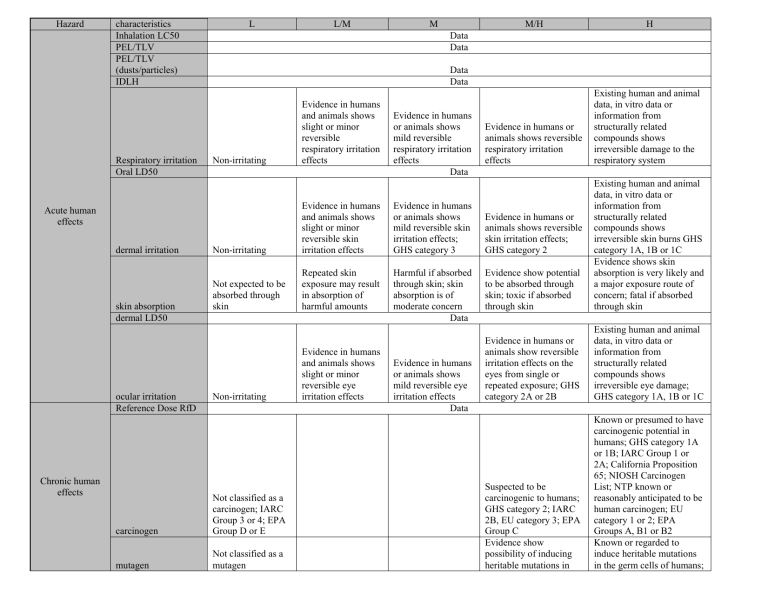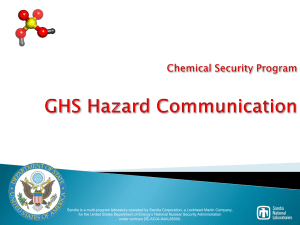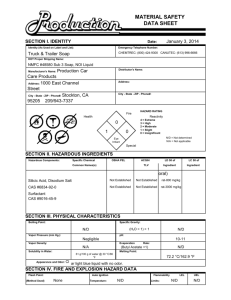Guidance on L-M-H assessment 2-27-14
advertisement

Hazard characteristics Inhalation LC50 PEL/TLV PEL/TLV (dusts/particles) IDLH Respiratory irritation Oral LD50 L skin absorption dermal LD50 ocular irritation Reference Dose RfD Chronic human effects M M/H H Evidence in humans or animals shows reversible respiratory irritation effects Existing human and animal data, in vitro data or information from structurally related compounds shows irreversible damage to the respiratory system Data Data Data Data Non-irritating Evidence in humans and animals shows slight or minor reversible respiratory irritation effects Evidence in humans or animals shows mild reversible respiratory irritation effects Data Non-irritating Evidence in humans and animals shows slight or minor reversible skin irritation effects Evidence in humans or animals shows mild reversible skin irritation effects; GHS category 3 Not expected to be absorbed through skin Repeated skin exposure may result in absorption of harmful amounts Harmful if absorbed through skin; skin absorption is of moderate concern Data Acute human effects dermal irritation L/M Non-irritating carcinogen Not classified as a carcinogen; IARC Group 3 or 4; EPA Group D or E mutagen Not classified as a mutagen Evidence in humans and animals shows slight or minor reversible eye irritation effects Evidence in humans or animals shows mild reversible eye irritation effects Data Evidence show potential to be absorbed through skin; toxic if absorbed through skin Existing human and animal data, in vitro data or information from structurally related compounds shows irreversible skin burns GHS category 1A, 1B or 1C Evidence shows skin absorption is very likely and a major exposure route of concern; fatal if absorbed through skin Evidence in humans or animals show reversible irritation effects on the eyes from single or repeated exposure; GHS category 2A or 2B Existing human and animal data, in vitro data or information from structurally related compounds shows irreversible eye damage; GHS category 1A, 1B or 1C Suspected to be carcinogenic to humans; GHS category 2; IARC 2B, EU category 3; EPA Group C Evidence show possibility of inducing heritable mutations in Known or presumed to have carcinogenic potential in humans; GHS category 1A or 1B; IARC Group 1 or 2A; California Proposition 65; NIOSH Carcinogen List; NTP known or reasonably anticipated to be human carcinogen; EU category 1 or 2; EPA Groups A, B1 or B2 Known or regarded to induce heritable mutations in the germ cells of humans; Evidence in humans or animals shows reversible skin irritation effects; GHS category 2 the germ cells of humans; GHS category 2; EU category 3 reproductive effects neurotoxicity developmental effects Respiratory sensitivity/disease other chronic organ effects heat noise generation vibration ergonomic hazard Physical hazards psychosocial hazard Not expected to cause reproductive effects Not classified or known to be neurotoxic Not expected to cause developmental effects Not expected to cause chronic organ effects or systemic toxicity Water-based or materials/processes which presents very low or no safety concerns to workers; workers motivated to develop and utilize skills on the job; opportunities for workers to be Chemical class known to produce neurotoxicity effects Chemical class known to produce developmental effects* Data Evidence shows temporary organ or systemic effects from which humans can recover following a reasonable period of time without significant alteration of structure or function; GHS category 3 Data Data Data Data Moderate safety concerns about work materials/processes; moderate job demands; workers involvement in decision making but with certain limitations; opportunity to develop and utilize GHS category 1A or 1B; EU category 1 or 2 Suspected human reproductive toxicant (damaging fertility or unborn child); GHS category 2; EU category 3 Animal studies and analog data suggest neurotoxicity effects* Known or presumed human reproductive toxicant (damaging fertility or unborn child); GHS category 1A or 1B; California Proposition 65; NTP Center for the Evaluation of Risks to Human Reproduction; EU category 1 or 2 Evidence in humans shows potential neurotoxicity effects* Animal studies and analog data suggest developmental effects* Evidence in humans shows developmental effects* Evidence from studies in experimental animals presumed to have the potential to be harmful to human health following single or repeated exposure; GHS category 2 Evidence in humans show significant toxicity from single or repeated exposure; Studies from experimental animals can be presumed to have the potential to produce significant toxicity in humans from single or repeated exposure; GHS category 1 Solvent-based or materials/processes which presents significant safety concerns to workers; high job demands and low or no decision making opportunities for workers; inability to develop or utilize acquired skills to full potential; high stress work environment involved in workrelated decision making; low stress work environment Aquatic hazards Persistence/ bioaccumulation Water Quality Criteria (HWQC) aquatic LC50 fish NOAEC plant EC 50 observed ecological effects persistence BOD half-life hydrolysis half-life bioconcentration bioconcentration factor (BCF) greenhouse gas Atmospheric hazard ozone depletor acid rain formation NESHAP Disposal hazard landfill EPCRA reportable quantity incineration recycling skills but not to full potential; some work-related stress Data Data Data Data Not harmful to aquatic organisms Not classified as being persistent BCF/BAF < 500; or absent such data, log kow < 4* Not listed as a greenhouse gas May cause harm Soil, sediment < 30 days; water < 7 days; or ready biodegradability* Soil, sediment 30 to 60 days; or water 7 to 40 days* Data Data Data BCF/BAF ≥ 500 to 1000; absent such data, log kow > 4 to 4.5; or suggestive evidence of bioaccumulation in humans or wildlife* Listed as a greenhouse gas with global warming potential similar to that of carbon dioxide (CO2) Not listed as an ozone depletor Not listed as a precursor of acid rain Not listed as a Hazardous Air Pollutant Recyclable; filterable Harmful Soil, sediment > 60 to 180 days; water > 40 to 60 days; or potential for long-range environmental transport* Soil, sediment > 180 days; or water > 60 days* BCF/BAF > 1000 to 5000; absent such data, log kow > 4.5 to 5; or weight of evidence demonstrates bioaccumulation in humans or wildlife* BCF/BAF > 5000; or absent of such data, log kow > 5* Listed as a greenhouse gas with global warming potential greater than that of carbon dioxide (CO2) Listed as an ozone depletor; Class I or II ozone depleting substances Listed as a precursor of acid rain Listed as a Hazardous Air Pollutant Limited use/emulsifier Data Incinerable with no hazardous byproducts Recyclable; Hazardous decomposition Limited use/emulsifier filterable vapor pressure solubility in water specific gravity flammability flash point reactivity Data Data Data Minimal flammability hazard; will not burn; NFPA or HMIS rating number 0 Slight flammability hazard; must be preheated before ignition can occur; NFPA or HMIS rating number 1 Minimal hazard; stable; NFPA or HMIS rating number 0 Slight hazard; normally stable but high temperatures make unstable; NFPA or HMIS rating number 1 Moderate flammability hazard; must be preheated or high ambient temperature to burn; NFPA or HMIS rating number 2 Data Moderate hazard; violent chemical change at high temperatures or pressures; NFPA or HMIS rating number 2 Serious flammability hazard; can be ignited under all ambient temperatures; NFPA or HMIS rating number 3 Serious hazard; may explode at high temperatures or shock; NFPA or HMIS rating number 3 Chemical hazard pH corrosivity High pressure system High temperature system mixture/reaction potential odor threshold volatile organic compound Energy & resource use non renewable resource water use Non corrosive (neutral pH) Severe flammability hazard; will vaporize and readily burn at normal temperatures; NFPA or HMIS rating number 4 Severe hazard; may explode at normal temperatures and pressures; NFPA or HMIS rating number 4 Existing human and animal data, in vitro data or information from structurally related compounds shows irreversible skin burns or eye damage; pH ≤ 2 or pH ≥ 11.5; GHS category 1A, 1B or 1C Data Immersion system Temperature > 68 to 77 °F; cold temperature; cold cleaning No hazardous byproducts formed when mixed with other chemicals used High pressure system; media blasting Temperature > 77 to 100 °F Temperature > 150 to 170 °F 25-49 Cascade rinsing 50-99 Aqueous-based solvents; semirenewable resource Semi-aqueous; multi Temperature > 170 °F; vapor degreasing Hazardous decomposition or mixtures formed when mixed with chemicals used Pungent odor; irritating odor; strong citrus smell; solvent smell Mild odor; faint odor; characteristic odor; citrus odor Odorless No VOC to 24 g/l Biobased substance; biomass; renewable resource Solvents used; no Temperature > 100 to 150 °F 100-300 Dump rinsing >300 Petroleum-based solvents; fossil fuels; nuclear power; non-renewable resource Aqueous; continuous flow rinsing; little to no water used energy use upstream effects Product hazard Temperature > 68 to 77 °F for cleaning; cold/room temperature cleaning; manual cleaning disposal hazard Aqueous; green cleaners, renewable materials Resources conserved; waste reduction Exposure potential Low dustiness; low volatility; no control equipment required; no exposure concerns consumer hazard Exposure potential stage rinsing without reuse; moderate quantities of water used Temperature > 77 to 100 °F for cleaning; immersion cleaning system Materials re-used more than once Temperature ≥ 100 to150 °F for cleaning; low pressure spray Recyclable; compostable Medium dustiness; medium volatility; control equipment recommended; concerns over potential exposure rinsing; significant quantities of water used Temperature > 150 to 170 °F for cleaning; heated cleaning; mechanical agitation Temperature > 150 °F for cleaning; vapor degreasing; ultrasonic; high pressure cleaning Recovery; incineration to convert waste to energy (power and/or heat) Solvent Landfill disposal; incineration; disposal without any value recovered High dustiness; high volatility; control equipment required; exposure very likely





